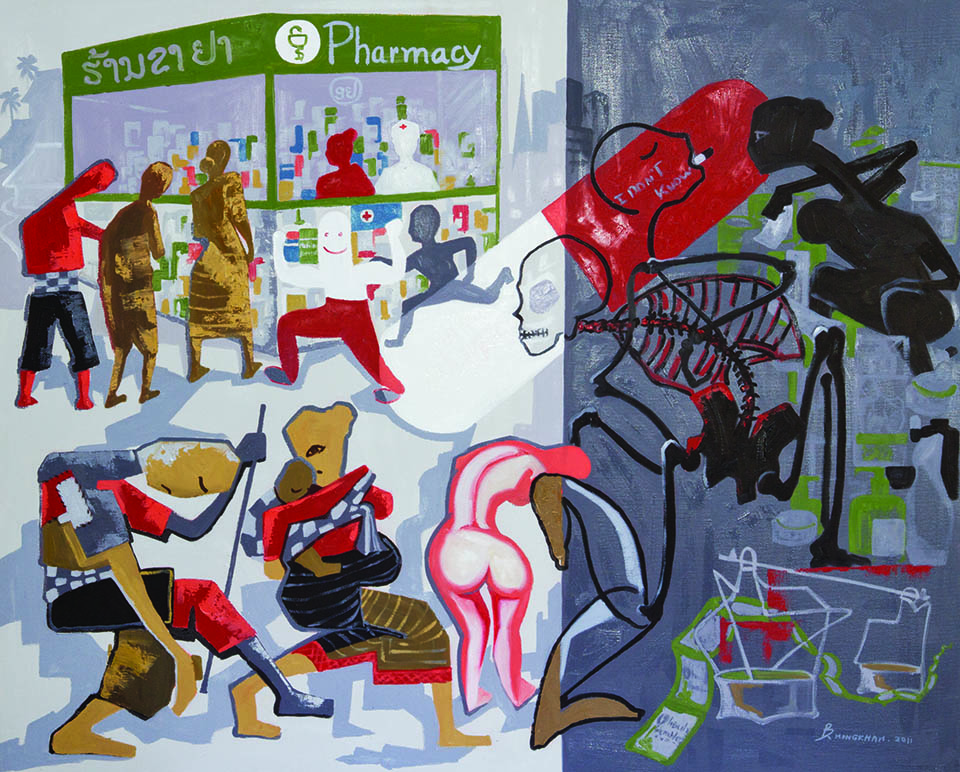When we are ill, we expect our medicines to work as intended. But what if they do not contain the ingredients listed on the packaging? The art exhibition “What’s in your medicines?” showcases the original artwork of 11 South East Asian artists. In their paintings, the artists explore how substandard (poor quality) and falsified (‘fake’) medicines affect people, society and public health in low- and middle-income countries (LMICs) in South East Asia.
The exhibition features artwork by Amphonesouk Paisourin, Ketsada Thammavongsa, Malisa Dalasavath and Mongkham Boualavanh (Laos), Hen Sophal, Sokuntevy Oeur and Sukuntak Piteak (Cambodia), Adhya Ranadireksa, Iwan Effendi and Iwan Wijono (Indonesia), and Nguyen Anh Tuan (Vietnam).
 Image credit | Mongkham Boualavanh (Mong)
Image credit | Mongkham Boualavanh (Mong)
Substandard medicines and vaccines contain incorrect ingredients due to production errors in factories or degradation in the supply chains. Falsified (‘fake’) medicines on the other hand are result from criminal fraud. The World Health Organisation estimates that in LMICs around 10% of medicines are substandard or falsified, but the true extent of the problem is still not known. Substandard and falsified medicines pose a significant threat to public health. They can prolong sickness, cause serious side effects, put pressure on doctors and hospitals, and damage people’s trust in health care. They are also likely to contribute to the rise of antimicrobial resistance: microorganisms like malaria parasites can become resistant to medicines, if the dose taken is too low.
The exhibition aims to raise awareness of the issues surrounding substandard and falsified medicines, and to stimulate discussion on how to tackle this complex problem. It is organized by the Medicine Quality Research Group from the Lao-Oxford-Mahosot Hospital Wellcome Trust Research Unit (LOMWRU) at Mahosot Hospital, Vientiane, Laos, and the Infectious Diseases Data Observatory (IDDO) in Oxford, United Kingdom. The exhibition runs alongside the “ISIUM Bangkok 2020” conference, held by the International Society to Improve the Use of Medicines (ISIUM).
The Medicine Quality Research Group at IDDO/LOMWRU, led by Prof Paul Newton and Dr Céline Caillet, studies the distribution, impact and detection of substandard and falsified medicines in South East Asia and around the world. For more information view podcasts with Paul Newton on Poor quality medicines and Céline Caillet discussing Improving medicine quality.
 Image credit | Sukuntak Piteak
Image credit | Sukuntak Piteak
Originally called ‘PHARMACIDE ARTS – Fake medicine : the disease of greed’, the exhibition toured South East Asia in 2012. Its production was supported by the French Ministry of European and Foreign Affairs, the Promoting the Quality of Medicines program funded by USAID, Soho Film & The Cecil and Hilda Lewis Charitable Trust, and Meta House. Its current tour is funded by a Wellcome Trust Provision for Public Engagement and supported by the Mahidol Oxford Tropical Medicine Research Unit (MORU) in Bangkok, Thailand.
The exhibition will be open to the public from 26th-28th January 2020 at the Mandarin Hotel, Bangkok, from 10 am – 5 pm. Entry is free, and no ticket booking is required.
Venue information: https://www.mandarin-bkk.com/
For more information about the exhibition, please contact: Rita@tropmedres.ac
For more information on substandard and falsified medical products, please contact medicinequality@iddo.org
This work is licensed under a Creative Commons Attribution 4.0 International License


Please Sign in (or Register) to view further.